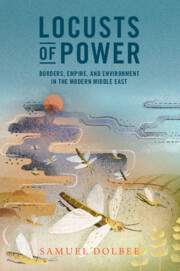Book contents
- Locusts of Power
- Reviews
- Studies in Environment and History
- Locusts of Power
- Copyright page
- Contents
- List of Figures and Maps
- Preface
- Acknowledgments
- Note on Spelling and Units of Measurement
- Introduction
- 1 Sultans of the Open Lands (1858–1890)
- 2 “Savage Swarms” (1890–1908)
- 3 “Weren’t We A Lot Like Those Creatures?” (1908–1918)
- 4 “Like Swarms of Locusts” (1918–1939)
- Conclusion
- Bibliography
- Index
Conclusion
Published online by Cambridge University Press: 16 June 2023
- Locusts of Power
- Reviews
- Studies in Environment and History
- Locusts of Power
- Copyright page
- Contents
- List of Figures and Maps
- Preface
- Acknowledgments
- Note on Spelling and Units of Measurement
- Introduction
- 1 Sultans of the Open Lands (1858–1890)
- 2 “Savage Swarms” (1890–1908)
- 3 “Weren’t We A Lot Like Those Creatures?” (1908–1918)
- 4 “Like Swarms of Locusts” (1918–1939)
- Conclusion
- Bibliography
- Index
Summary
In 1953, a Syrian entomologist by the name of Rafeq Skaf ventured about fifty kilometers (thirty-one miles) east of the Syrian city of Raqqa. There, on “an ancient hill with ruins,” he saw “the population … copulating and lying.” They were locusts. And the site at which they procreated was a tall, the ancient human infrastructure that gave life to swarm after swarm of insects in the Jazira. Skaf’s observation of locusts belied any facile narrative of the total annihilation of the insects. But his report also attested to change. For so long, locusts had appeared as if out of nowhere. Yet in Skaf’s view, by 1953 there was a pattern to their range. Where there were nomads, there were locusts. As he put it, the locusts may as well have been considered a “permanent citizen” anywhere there was “grazing” or “almost permanent tents.” The humans and insects had been metaphorically linked by the denigration of state officials and corporeally linked by arsenic compounds. Skaf connected them in terms of ecology and also, significantly, permanence, anathema to the mobility that haunted state efforts at control in the Jazira for so long.
- Type
- Chapter
- Information
- Locusts of PowerBorders, Empire, and Environment in the Modern Middle East, pp. 254 - 268Publisher: Cambridge University PressPrint publication year: 2023



